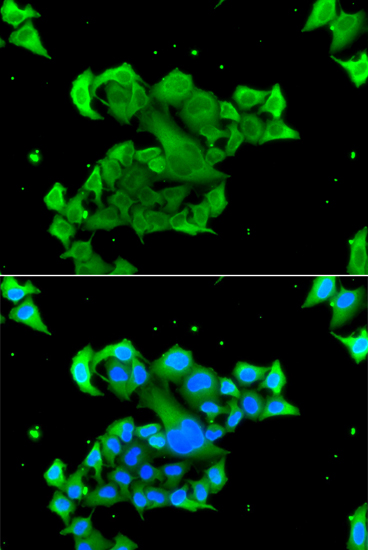Epigenetics & Nuclear Signaling Antibodies 3
Anti-Rad51D Antibody (CAB4068)
- SKU:
- CAB4068
- Product Type:
- Antibody
- Reactivity:
- Human
- Reactivity:
- Mouse
- Reactivity:
- Rat
- Host Species:
- Rabbit
- Isotype:
- IgG
- Research Area:
- Epigenetics and Nuclear Signaling
Description
| Antibody Name: | Anti-Rad51D Antibody |
| Antibody SKU: | CAB4068 |
| Antibody Size: | 20uL, 50uL, 100uL |
| Application: | WB IF |
| Reactivity: | Human, Mouse, Rat |
| Host Species: | Rabbit |
| Immunogen: | Recombinant fusion protein containing a sequence corresponding to amino acids 1-328 of human Rad51D (NP_002869.3). |
| Application: | WB IF |
| Recommended Dilution: | WB 1:500 - 1:2000 IF 1:50 - 1:200 |
| Reactivity: | Human, Mouse, Rat |
| Positive Samples: | HL-60, Jurkat, HT-29, Mouse liver, Rat liver |
| Immunogen: | Recombinant fusion protein containing a sequence corresponding to amino acids 1-328 of human Rad51D (NP_002869.3). |
| Purification Method: | Affinity purification |
| Storage Buffer: | Store at -20'C. Avoid freeze / thaw cycles. Buffer: PBS with 0.02% sodium azide, 50% glycerol, pH7.3. |
| Isotype: | IgG |
| Sequence: | MGVL RVGL CPGL TEEM IQLL RSHR IKTV VDLV SADL EEVA QKCG LSYK ALVA LRRV LLAQ FSAF PVNG ADLY EELK TSTA ILST GIGS LDKL LDAG LYTG EVTE IVGG PGSG KTQV CLCM AANV AHGL QQNV LYVD SNGG LTAS RLLQ LLQA KTQD EEEQ AEAL RRIQ VVHA FDIF QMLD VLQE LRGT VAQQ VTGS SGTV KVVV VDSV TAVV SPLL GGQQ REGL ALMM QLAR ELKT LARD LGMA VVVT NHIT RDRD SGRL KPAL GRSW SFVP STRI LLDT IEGA GASG GRRM ACLA KSSR QPTG FQEM VDIG TWGT SEQS ATLQ GDQT |
| Gene ID: | 5892 |
| Uniprot: | O75771 |
| Cellular Location: | Chromosome, Cytoplasm, Nucleus, centrosome, cytoskeleton, microtubule organizing center, telomere |
| Calculated MW: | 5kDa/12kDa/22kDa/23kDa/30kDa/35kDa/37kDa |
| Observed MW: | 35kDa |
| Synonyms: | RAD51D, BROVCA4, R51H3, RAD51L3, TRAD, Rad51D |
| Background: | The protein encoded by this gene is a member of the RAD51 protein family. RAD51 family members are highly similar to bacterial RecA and Saccharomyces cerevisiae Rad51, which are known to be involved in the homologous recombination and repair of DNA. This protein forms a complex with several other members of the RAD51 family, including RAD51L1, RAD51L2, and XRCC2. The protein complex formed with this protein has been shown to catalyze homologous pairing between single- and double-stranded DNA, and is thought to play a role in the early stage of recombinational repair of DNA. Alternative splicing results in multiple transcript variants. Read-through transcription also exists between this gene and the downstream ring finger and FYVE-like domain containing 1 (RFFL) gene. |
| UniProt Protein Function: | RAD51L3: Involved in the homologous recombination repair (HRR) pathway of double-stranded DNA breaks arising during DNA replication or induced by DNA-damaging agents. The BCDX2 complex binds single-stranded DNA, single-stranded gaps in duplex DNA and specifically to nicks in duplex DNA. Defects in RAD51D are a cause of susceptibility to familial breast-ovarian cancer type 4 (BROVCA4). A condition associated with familial predisposition to cancer of the breast and ovaries. Characteristic features in affected families are an early age of onset of breast cancer (often before age 50), increased chance of bilateral cancers (cancer that develop in both breasts, or both ovaries, independently), frequent occurrence of breast cancer among men, increased incidence of tumors of other specific organs, such as the prostate. Belongs to the RecA family. RAD51 subfamily. 8 isoforms of the human protein are produced by alternative splicing. |
| UniProt Protein Details: | Protein type:DNA-binding Chromosomal Location of Human Ortholog: 17q11 Cellular Component: centrosome; chromosome, telomeric region; cytoplasm; nuclear chromosome, telomeric region; nucleoplasm; nucleus; replication fork Molecular Function:ATP binding; DNA binding; DNA-dependent ATPase activity; double-stranded DNA binding; endodeoxyribonuclease activity; four-way junction DNA binding; gamma-tubulin binding; protein binding; recombinase activity; single-stranded DNA binding Biological Process: DNA repair; double-strand break repair; double-strand break repair via homologous recombination; double-strand break repair via synthesis-dependent strand annealing; meiotic DNA recombinase assembly; meiotic recombination; mitotic recombination; nucleotide-excision repair; regulation of cell cycle; response to ionizing radiation; strand invasion; telomere maintenance Disease: Breast-ovarian Cancer, Familial, Susceptibility To, 4 |
| NCBI Summary: | The protein encoded by this gene is a member of the RAD51 protein family. RAD51 family members are highly similar to bacterial RecA and Saccharomyces cerevisiae Rad51, which are known to be involved in the homologous recombination and repair of DNA. This protein forms a complex with several other members of the RAD51 family, including RAD51L1, RAD51L2, and XRCC2. The protein complex formed with this protein has been shown to catalyze homologous pairing between single- and double-stranded DNA, and is thought to play a role in the early stage of recombinational repair of DNA. Alternative splicing results in multiple transcript variants. Read-through transcription also exists between this gene and the downstream ring finger and FYVE-like domain containing 1 (RFFL) gene. [provided by RefSeq, Jan 2011] |
| UniProt Code: | O75771 |
| NCBI GenInfo Identifier: | 6174940 |
| NCBI Gene ID: | 5892 |
| NCBI Accession: | O75771.1 |
| UniProt Secondary Accession: | O75771,O43537, O60355, O75196, O75847, O75848, O76073 O76085, O94908, Q9UFU5, B4DJU7, E1P637, |
| UniProt Related Accession: | O75771 |
| Molecular Weight: | 37,014 Da |
| NCBI Full Name: | DNA repair protein RAD51 homolog 4 |
| NCBI Synonym Full Names: | RAD51 paralog D |
| NCBI Official Symbol: | RAD51D |
| NCBI Official Synonym Symbols: | TRAD; R51H3; BROVCA4; RAD51L3 |
| NCBI Protein Information: | DNA repair protein RAD51 homolog 4 |
| UniProt Protein Name: | DNA repair protein RAD51 homolog 4 |
| UniProt Synonym Protein Names: | R51H3; RAD51 homolog D; RAD51-like protein 3; TRAD |
| Protein Family: | DNA repair protein |
| UniProt Gene Name: | RAD51D |
| UniProt Entry Name: | RA51D_HUMAN |








